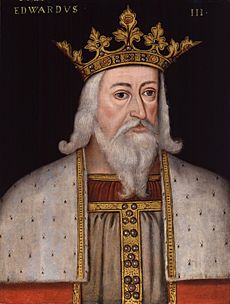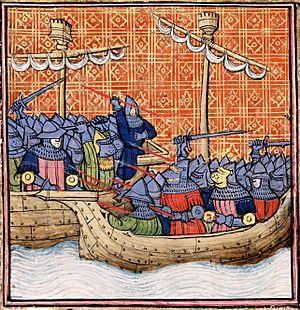Battle of La Rochelle facts for kids
Quick facts for kids Battle of La Rochelle |
|||||||
|---|---|---|---|---|---|---|---|
| Part of the Caroline phase of the Hundred Years' War | |||||||
 The naval battle of La Rochelle, chronicle of Jean Froissart, 15th century. |
|||||||
|
|||||||
| Belligerents | |||||||
| Commanders and leaders | |||||||
| Ambrosio Boccanegra | |||||||
| Strength | |||||||
| 14–57 ships and barges | 22 ships | ||||||
| Casualties and losses | |||||||
| 48 ships sunk or captured 400 knights and 8,000 soldiers captured Whole fleet sunk or captured 800 men killed Between 160 and 400 knights prisoners |
minor | ||||||
The Battle of La Rochelle was a major naval battle fought on June 22 and 23, 1372. It took place between a fleet from Castile (a kingdom in what is now Spain) and an English fleet. The Castilian fleet was led by Admiral Ambrosio Boccanegra. The English fleet was commanded by John Hastings, 2nd Earl of Pembroke.
The Castilian fleet was sent to attack the English near La Rochelle. This French town was being surrounded by French forces. Pembroke was on his way to La Rochelle with soldiers and money. He planned to use the money to hire more soldiers in the region of Aquitaine.
Historians have different ideas about how many ships were in each fleet. The Castilian fleet probably had about 22 ships. These were mainly galleys, which are ships powered by oars, and some large sailing ships called carracks. The English fleet might have had around 32 ships and 17 smaller barges.
The Castilian fleet won a complete victory. They captured or destroyed the entire English fleet. This defeat was a big blow to England. It made it harder for them to trade by sea and send supplies through the English Channel. It also put their lands in Gascony (part of Aquitaine) at risk.
Contents
Why the Battle Happened

In 1372, the English king, Edward III, planned an important military mission in Aquitaine. This area was a large territory in France controlled by England. The Earl of Pembroke was put in charge of this mission. He was supposed to serve for a year in Aquitaine. He brought a group of 24 knights, 55 squires, and 80 archers.
Pembroke also had a large sum of money, about £12,000. His instructions were to use this money to hire a large army of 500 knights, 1,500 squires, and 1,500 archers in France. A clerk named John Wilton went with the Earl to manage these funds.
Pembroke and his group sailed from Plymouth on a fleet of transport ships. These ships were not ready for a big naval fight. Some historians say there were about 36 English ships. Others say there were fewer, perhaps 14 to 20 ships. Sir Philip Courtenay, an English admiral, provided three larger fighting ships to protect the fleet.
At this time, England's control over Aquitaine was in danger. Since 1370, the French had taken back many parts of the region. In 1372, a French general named Bertrand du Guesclin was surrounding the town of La Rochelle. To help their French allies, the king of Castile, Henry II, sent a fleet to Aquitaine. This Castilian fleet was led by Ambrosio Boccanegra.
The exact size of the Castilian fleet is also debated. Some say it had 12 galleys. Others claim it had 40 sailing ships and 13 barges, or even 20 to 22 galleys.
The Battle Begins
On June 21, the English fleet arrived at La Rochelle. The battle started as Pembroke's ships got close to the harbor. The harbor was in an inlet that was hard to navigate when the water was low. The first attacks by the Castilians were met with strong resistance. Even though they had fewer ships, the English fought bravely.
As evening came and the tide rose, the two fleets separated. The English had lost a few ships, but they were not yet defeated. Pembroke moved his ships away from the land. Boccanegra anchored his fleet in front of La Rochelle. Some accounts say that only small fights happened on the first day. Boccanegra might have held back his galleys for the main battle.
During the night, Pembroke and his men discussed how to escape. They thought about trying to leave under the cover of darkness. But they worried about the Castilian galleys. They also considered entering La Rochelle, but the water was too shallow for their ships.
A Difficult Fight
The next morning, on June 22, the low tide left the English ships stuck in the mud. This was a huge problem for them. The Castilian galleys, however, could move freely in the shallow water. This gave them a big advantage.
Another problem for the English was the height of the Castilian ships. The Castilian ships were taller. This allowed their crews to build wooden shields and shoot arrows and bolts down onto the English ships from a higher position. The Castilian ships also had powerful crossbows. These crossbows shot heavy bolts onto the wooden decks of the English ships.
When the fighting started again, the Castilians used a clever tactic. They sprayed oil onto the decks and rigging (ropes and sails) of the English ships. Then, they shot flaming arrows to set the ships on fire. Many English sailors were killed or burned alive. Others surrendered, including Earl Pembroke himself.
Some historians say that 400 knights and 8,000 soldiers were captured. Other English records suggest about 1,500 casualties in total. This included 800 deaths and between 160 and 400 prisoners. The entire English fleet was either destroyed or captured. The £12,000 that Pembroke was carrying also fell into Castilian hands. The English defeat seemed unavoidable because of the big difference in strength.
What Happened Next
The Battle of La Rochelle was the first major English naval defeat in the Hundred Years' War. Some historians call it the worst defeat ever for the English navy. It had a big impact on the war. La Rochelle was lost to the French soon after the battle, on September 7.
After this, nearly all of Poitou, Angoumois, and Saintonge were taken back by the French. Bertrand du Guesclin cleared these areas of English soldiers. Some people believe this battle cost England its control of the seas along the French coast. Others disagree, but they do say England's naval strategy was not good.
The English needed a year to rebuild their fleet. Fourteen towns worked together to build new ships. In April 1373, a strong English force sailed to Portugal. This fleet had 44 fighting ships, plus more ships that joined later. By July, the English had 56 ships and an army of 2,600 soldiers. This campaign in 1373 was successful. For example, they burned a Castilian merchant convoy at Saint-Malo.
In response, Fernando Sánchez de Tovar, who became the new Admiral of Castile, joined forces with the French admiral Jean de Vienne. They used their control of the English Channel to attack England. Between 1374 and 1380, their combined fleet raided and burned the Isle of Wight. They also attacked English ports like Rye, Rottingdean, Winchelsea, Lewes, Folkestone, Plymouth, Portsmouth, and Hastings. In 1380, the joint fleet even sailed up the Thames River and burned Gravesend, which is over 20 miles east of London.
Images for kids
-
Main attacks on England by Tovar and Vienne (1374–1380)
See also
 In Spanish: Batalla de La Rochelle (1372) para niños
In Spanish: Batalla de La Rochelle (1372) para niños



